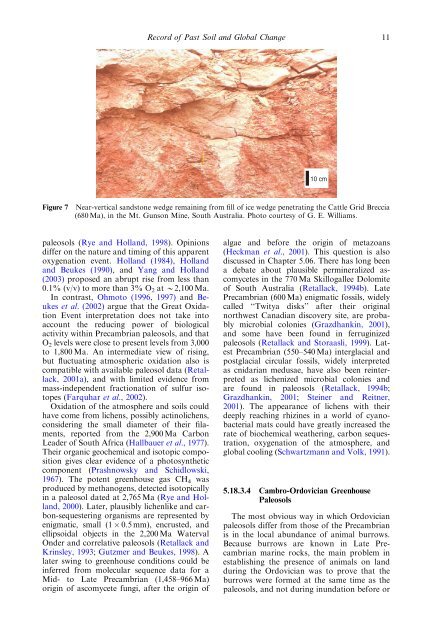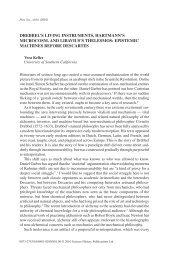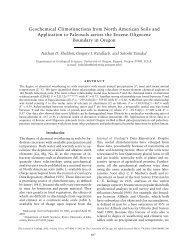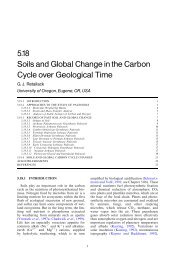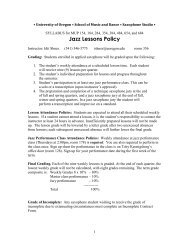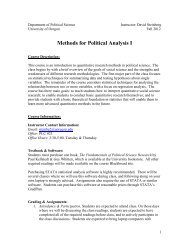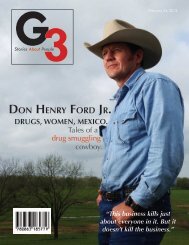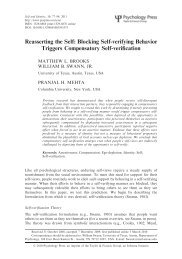10 Soils and Global Change in the Carbon Cycle over Geological Timecarbon comparable with that <strong>of</strong> well-drainedpaleosols <strong>of</strong> the Phanerozoic. If life had beenpresent in the Early Precambrian paleosols,they would have become carbonaceous in theabsence <strong>of</strong> a decomposing microbiota <strong>of</strong> actinobacteriaand <strong>of</strong> fungi and metazoans duringthe later Precambrian. Isotopic evidence thussuggests that methanogenic, hypersaline, normal,and decompositional microbes were presentin Precambrian paleosols. Other evidencefor life in Precambrian paleosols includes micr<strong>of</strong>ossils(1,300 Ma; Horodyski and Knauth,1994), microbial trace fossils (2,200 Ma; <strong>Retallack</strong>and Krinsley, 1993), chem<strong>of</strong>ossils(2,900 Ma; Prashnowsky and Schidlowski,1967), plausible megafossils (2,900 Ma; Hallbaueret al., 1977; <strong>Retallack</strong>, 1994b), and theimpressive thickness and soil structure <strong>of</strong> Precambrianpaleosols (3,500 Ma; <strong>Retallack</strong>, 1986,2001a; Buick et al., 1995; Gutzmer and Beukes,1998; Beukes et al., 2002). Life and its byproductssuch as polysaccharides may havebeen soil binders, like molasses applied to acornfield (Foster, 1981), protecting soils fromphysical weathering so that biochemical weatheringcould proceed.The likely existence <strong>of</strong> microbial mats at thesoil surface considerably complicates the use <strong>of</strong>paleosols as indicators <strong>of</strong> ancient atmospheres(Ohmoto, 1996). Tropical rainforest soils nowhave soil CO 2 levels up to 110 times that <strong>of</strong> theatmosphere, because <strong>of</strong> high levels <strong>of</strong> soil respirationby termites and microbes <strong>of</strong> an abundantsupply <strong>of</strong> soil organic matter that forms ina living membrane separating the subsoil fromthe atmosphere (Brook et al., 1983; Colin et al.,1992). Nevertheless, modeling by Pinto andHolland (1988) makes it unlikely that microbialscums <strong>of</strong> the Precambrian were as productiveand effective membranes as rainforests.The observation that Precambrian paleosolswere chemically weathered to an extent comparablewith rainforest soils today probablyindicates much higher levels <strong>of</strong> CO 2 in the atmosphereat that time (Holland, 1984). Theextent <strong>of</strong> this greenhouse is poorly constrained,but the apparent lack <strong>of</strong> siderite in paleosolssuch as the Hekpoort and Mt. Roe paleosolshas been used by Rye et al. (1995) to argue thatCO 2 concentrations could not have been morethan ca. 100 times present levels before the rise<strong>of</strong> oxygen at ca. 2,100 Ma.Siderite is common in Phanerozoic wetlandpaleosols (Ludvigsen et al., 1998) in which respiredsoil CO 2 exceeded this level. Thus, theestimate <strong>of</strong> Rye et al. (1995) <strong>of</strong> no more than100 times present levels <strong>of</strong> soil CO 2 also is acap on soil respiration and biological productivityduring the Precambrian (Sheldonet al., 2001). The contribution <strong>of</strong> CH 4 to theatmospheric greenhouse effect was probablyalso much higher than at present, becauseit was necessary to maintain planetary temperaturesabove that <strong>of</strong> the freezing <strong>of</strong> water atthe time <strong>of</strong> a faint young Sun (Kasting, 1992;Pavlov et al., 2000).5.18.3.3 Proterozoic Icehouse PaleosolsThe oldest known periglacial paleosolsare from the 2,300 to 2,400 Ma Ramsay LakeFormation <strong>of</strong> Ontario, Canada (Young andLong, 1976; Schmidt and Williams, 1999). Theyhave prominent ice wedges, which are stronglytapering cracks filled originally with ice, butnow with massive or horizontally layered sandand claystone breccia. Modern ice wedges formin climates with a mean annual temperature<strong>of</strong> 4to 8 1C, coldest month temperatures <strong>of</strong>25 to 40 1C, warmest month temperatures<strong>of</strong> 10–20 1C, and a mean annual precipitation<strong>of</strong> 50–500 mm (Williams, 1986; Bockheim,1995). Periglacial paleosols <strong>of</strong> the Late Precambrian(600–1,000 Ma) in Scotland, Norway,and South Australia include sand wedges(Figure 7), which indicate an even drier andmore frigid climate: a mean annual temperature<strong>of</strong> 12 to 20 1C, a mean cold-monthtemperature <strong>of</strong> 35 1C, a mean warm-monthtemperature <strong>of</strong> 4 1C, and mean annual precipitation<strong>of</strong> 100 mm (Williams, 1986). Some <strong>of</strong>the Late Precambrian glaciations were remarkablein extending to very low latitudes, as indicatedby the paleomagnetic inclination <strong>of</strong>glaciogene sediments, and have been dubbedSnowball Earth events (Kirschvink, 1992;H<strong>of</strong>fman et al., 1998; Schmidt and Williams,1999). Between and before these Precambrianepisodes <strong>of</strong> periglacial paleosols and associatedglaciogene sediments there is no evidence <strong>of</strong>frigid conditions, so that the alternation <strong>of</strong>global icehouse and greenhouse paleoclimatesis ancient indeed.These climatic fluctuations could be attributedto changes in solar luminosity, volcanicdegassing, or ocean current reorganization withcontinental drift (Barley et al., 1997; Dalziel,1997), but paleosols reveal that these ice ageswere also times <strong>of</strong> change in the atmosphereand life on land. Highly ferruginized pisoliticlateritic paleosols first appear in the geologicalrecord at 2,200–1,920 Ma in South Africa(Gutzmer and Beukes, 1998; Beukes et al.,2002). The lateritic paleosols are part <strong>of</strong> acomplex erosional landscape with a variety <strong>of</strong>paleosols <strong>of</strong> significantly different geologicalages, including mildly oxidized (<strong>Retallack</strong>,1986; Maynard, 1992) and chemically reduced
Record <strong>of</strong> Past Soil and Global Change 1110 cmFigure 7Near-vertical sandstone wedge remaining from fill <strong>of</strong> ice wedge penetrating the Cattle Grid Breccia(680 Ma), in the Mt. Gunson Mine, South Australia. Photo courtesy <strong>of</strong> G. E. Williams.paleosols (Rye and Holland, 1998). Opinionsdiffer on the nature and timing <strong>of</strong> this apparentoxygenation event. Holland (1984), Hollandand Beukes (1990), and Yang and Holland(2003) proposed an abrupt rise from less than0.1% (v/v) to more than 3% O 2 at B2,100 Ma.In contrast, Ohmoto (1996, 1997) and Beukeset al. (2002) argue that the Great OxidationEvent interpretation does not take intoaccount the reducing power <strong>of</strong> biologicalactivity within Precambrian paleosols, and thatO 2 levels were close to present levels from 3,000to 1,800 Ma. An intermediate view <strong>of</strong> rising,but fluctuating atmospheric oxidation also iscompatible with available paleosol data (<strong>Retallack</strong>,2001a), and with limited evidence frommass-independent fractionation <strong>of</strong> sulfur isotopes(Farquhar et al., 2002).Oxidation <strong>of</strong> the atmosphere and soils couldhave come from lichens, possibly actinolichens,considering the small diameter <strong>of</strong> their filaments,reported from the 2,900 Ma CarbonLeader <strong>of</strong> South Africa (Hallbauer et al., 1977).Their organic geochemical and isotopic compositiongives clear evidence <strong>of</strong> a photosyntheticcomponent (Prashnowsky and Schidlowski,1967). The potent greenhouse gas CH 4 wasproduced by methanogens, detected isotopicallyin a paleosol dated at 2,765 Ma (Rye and Holland,2000). Later, plausibly lichenlike and carbon-sequesteringorganisms are represented byenigmatic, small (1 0.5 mm), encrusted, andellipsoidal objects in the 2,200 Ma WatervalOnder and correlative paleosols (<strong>Retallack</strong> andKrinsley, 1993; Gutzmer and Beukes, 1998). Alater swing to greenhouse conditions could beinferred from molecular sequence data for aMid- to Late Precambrian (1,458–966 Ma)origin <strong>of</strong> ascomycete fungi, after the origin <strong>of</strong>algae and before the origin <strong>of</strong> metazoans(Heckman et al., 2001). This question is alsodiscussed in Chapter 5.06. There has long beena debate about plausible permineralized ascomycetesin the 770 Ma Skillogallee Dolomite<strong>of</strong> South Australia (<strong>Retallack</strong>, 1994b). LatePrecambrian (600 Ma) enigmatic fossils, widelycalled ‘‘Twitya disks’’ after their originalnorthwest Canadian discovery site, are probablymicrobial colonies (Grazdhankin, 2001),and some have been found in ferruginizedpaleosols (<strong>Retallack</strong> and Storaasli, 1999). LatestPrecambrian (550–540 Ma) interglacial andpostglacial circular fossils, widely interpretedas cnidarian medusae, have also been reinterpretedas lichenized microbial colonies andare found in paleosols (<strong>Retallack</strong>, 1994b;Grazdhankin, 2001; Steiner and Reitner,2001). The appearance <strong>of</strong> lichens with theirdeeply reaching rhizines in a world <strong>of</strong> cyanobacterialmats could have greatly increased therate <strong>of</strong> biochemical weathering, carbon sequestration,oxygenation <strong>of</strong> the atmosphere, andglobal cooling (Schwartzmann and Volk, 1991).5.18.3.4 Cambro-Ordovician GreenhousePaleosolsThe most obvious way in which Ordovicianpaleosols differ from those <strong>of</strong> the Precambrianis in the local abundance <strong>of</strong> animal burrows.Because burrows are known in Late Precambrianmarine rocks, the main problem inestablishing the presence <strong>of</strong> animals on landduring the Ordovician was to prove that theburrows were formed at the same time as thepaleosols, and not during inundation before or


